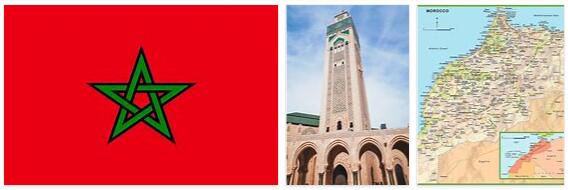GEOGRAPHICAL POSITION
Morocco is washed in the north by the waters of the Mediterranean Sea and in the west by the Atlantic Ocean. The Strait of Gibraltar separates Morocco from Europe. In the east and southeast it borders on Algeria, in the south – on Western Sahara. The total area of the country is 446,550 km². According to this indicator, Morocco ranks 57th in the world. The total length of land borders is 2018 km. Coastline of the country: 1835 km. On the northern coast of Morocco are the Spanish territories of Ceuta and Melilla (sovereign territories of Spain). The country is divided into four physiographic regions:
- Er-Rif, or mountainous region, lying parallel to the Mediterranean coast;
- the Atlas Mountains, stretching across the country from the southwest to the northeast from the Atlantic Ocean to Rif, from which they are separated by the Taza depression;
- Region of the vast coastal plains of the Atlantic coast;
- Valleys lying south of the Atlas Mountains, merging into the desert.
The highest point in the country – Mount Jebel Toubkal (4165 m) – is located in the High Atlas ridge. Rif rises to (2440 m) above sea level, Sebha Tah is the lowest located place in Morocco – 55 meters below sea level. The main rivers of the country are the Muluya, which flows into the Mediterranean Sea, and the Cebu, which flows into the Atlantic Ocean.
GOVERNMENT
The country’s territory is divided into provinces and prefectures, which are combined into 16 regions, including one region entirely, and two partially located in Western Sahara. Moroccan government, unlike most African countries, is a constitutional monarchy. The head of state is the king. The throne is passed exclusively through the male line from father to eldest son. The king rules for life or until he abdicates. Since 1666, the country has been ruled by the Alaouite dynasty. Until the 1950s, the head of state bore the title of Sultan. The head of government is the prime minister. The executive power is vested in the government, and the legislative power is in the bicameral parliament (Mejlis), elected on a multi-party basis. The Majlis of Representatives consists of 325 members (30 of them women), elected for 5 years. The Majlis of Councilors consists of 270 members and is elected for a nine-year term. However, the power of the king of Morocco, although limited by the constitution, is not symbolic, as with most European monarchs. The king has the right to appoint and remove the prime minister, as well as to dissolve parliament and call new elections. The judiciary is legally independent, however, the members of the Supreme Court are appointed by the monarch.
CLIMATE
The climate when moving through the territory of Morocco changes somewhat. On the Mediterranean coast of the country, the climate is mild, subtropical. The average temperature here in summer is about + 24-28 C (sometimes reaching + 30-35 C), and in winter + 10-12 C. When moving south, the climate becomes more and more continental, with hot (up to +37 C) summers and cool (up to + 5 C) in winter. The daily temperature difference can reach 20 degrees. The northwestern part of the country is greatly influenced by air masses from the Atlantic Ocean. Because of this, the climate here is cooler, and daily temperature fluctuations are much stronger than in the rest of the country. In the mountainous regions of the Atlas, the climate is highly dependent on the altitude of the place. On the western slopes of the Atlas, precipitation occurs from time to time, while in the southeast of the country there are years when precipitation does not fall at all.
LANGUAGE
The official language is Arabic. The spoken Moroccan dialect is lexically and grammatically far behind both the Arabic literary language and other dialects of Arabic (practically incomprehensible in the Arab countries of the Middle East). The following languages are widely spoken: French, Berber and Spanish (in the north of the country). Approximately 12 million (40% of the total population), especially in rural areas, speak the Berber language, which exists in Morocco in the form of 3 dialects. French, which is not the official language, but is actually regarded as the second language of Morocco, is widely used in business and economics. It is also widely used in educational and government fields. Also, the use of Spanish is common (especially in the north of the country).
POPULATION
The population of Morocco is Moroccans numbering 36.5 million people (July 2019 estimate). It is the third most populous Arabic-speaking country in the world after Egypt and Sudan. About 60% of the population are Arabs, about 40% are Berbers. A small number of Jews (70 thousand). The process of merging various tribes and peoples into a single Moroccan nation has not been fully completed.
RELIGION
Islam is the state religion. Morocco. 98.7% of Moroccans are Sunni Muslims, 1.1% are Christians, 0.2% are Jews
TRANSPORT
Rail transport in Morocco is operated by the national operator ONCF Morocco has a developed road network, one of the best in Africa. The total length of roads in 1973 was over 51,000 km, of which 21,000 were paved roads. Roads that are part of the Trans-African Highway Network pass through Morocco. In Morocco, 4 airports have international status. Several ferry lines link Morocco with Spain, France and Italy. Bus connections between cities and taxis are also common. A convenient and inexpensive way to get around the city is checkered city taxis. Stop anywhere, just raise your hand. Taxi can take only three people. Payment strictly according to the counter. When landing on the counters 1.70 Dirhams. Tipping in taxis is not customary. Suburban taxis (usually white Mercedes). They travel around the city and between cities. Accommodates up to 6 people. Payment for them is either per seat or negotiable.
